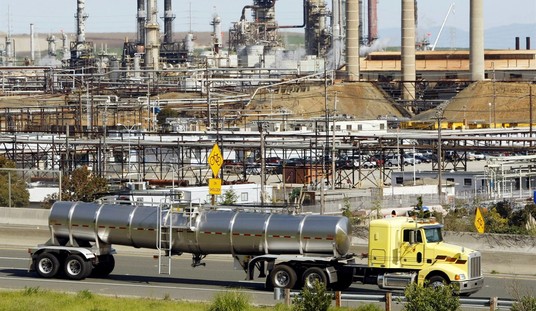Belmont Club Commenter L3 has an theory on why oil prices have swung from their recent heights to their recent lows. Below the “Read More”
The key here is exchange rates and the impact of increased consumer spending driven by the housing bubble and foreign investment by US investors.
From 2005-2007, the driving force of global economic expansion was increasing US consumption driven by mortgage equity withdrawals.
MEW is the money cashed out by both refinancings and home equity loans. Historically, this number hovered around 1% of GDP. Starting in 1998, it started to rise due to easier underwriting standards for mortgages, which drove up home prices and created more “equity” which could then be withdrawn. By 2003, it was up to 5% of GDP, and stayed there until early 2008, when it started to plummet – recently going negative. This represents trillions of dollars of consumer demand.
Lots of this demand was met by foreign suppliers, most notably China. To buy something from China, US consumers had to sell US dollars and buy Chinese yuan. This meant that dollars got cheaper, and commodities (like oil) got more expensive. Since dollars were worth less, it simply took more of them to buy a barrel of oil.
You can also see these goods and capital flows in our current account deficit, which continued to balloon throughout this entire period. We were buying more stuff from overseas, and our trade deficit expanded.
At the same time, investors, concerned about the weakening dollar, began moving more and more capital overseas. This put further pressure on the dollar, as every time a US investor wanted to buy, say, stock in a Turkish company, they had to sell dollars and buy lira.
The bottom line is that the dollar got cheaper and cheaper, and oil got more and more expensive. You can see this in the Euro-USD exchange rate, which rose from about 1.19 in 2006 to about 1.59 in July 2008, a rise of 33%. During this same time, oil rose from the $55-75 range to about $90-110 range, which more than like 60%. So about half of the price increase was simply due to exchange rates.
The rest of this increase was due to rising demand, again driven by US consumption driving increased production in China, etc. As we cashed out home equity and bought more stuff, that stuff had to be produced, and this drove up energy demand around the world. Supply is pretty inelastic, so prices rose. This, of course, led to efforts to increase supply, but those efforts take a long time to bear fruit.
Finally, towards the end of this run-up, you had the normal financial speculative excess that one normally sees in asset bubbles. That’s probably what drive the price from $100 to $140 per barrel in the 100 days between late February and mid-June.
Then the wheels started coming off. Oil prices fell from $145.31 on 7 July 2008 to $91.45 on 17 Sept 2008. During this period, we saw the failure of Fannie and Freddie (late August), Lehman Brothers (15 Sept 2008), and AIG was taken over (17 Sept 2008). The world suddenly realized that the financial markets were in deep doo-doo.
At this point, financial investors the world over made a collective (though uncoordinated IMHO) decision that the only asset that was a safe store of value was US Treasuries. In a so-called “flight to safety,” everyone and their dog started selling whatever they could and bought T-bills, which means that the entire world started buying dollars. On 11 Sept 2008, 1-month T-Bills had a closing yield of 1.525%. On 17 Sept 2008, they had a closing yield of 0.01%. Other term securities saw similar (though less severe) drops in yield. This is a breathtaking flow of capital into US Treasuries, and therefore dollars.
At the same time, the high crude prices starting hitting the consumer in the gas tank. Gasoline peaked at $4.16 per gallon in August 2008 (it takes a while for oil inventory to get processed and distributed, which accounts for the lag between oil price peaks and gasoline price peaks). Consumers started throttling back (so to speak) their consumption of gasoline, which accounts for a huge portion of oil consumption (about 2/3rds according the DoE). Energy costs also started to hit overall economic growth, especially in distribution and transportation businesses.
Consumers, faced with higher costs and less money (falling mortgage equity withdrawals), pulled back dramatically. The result was a sharp drop in demand, and therefore prices.
All of this goes back to the mortgage debacle, in which Jack and Jill went up the hill to fetch a big new home. Eased underwriting standards drove up home values (money flowing into housing faster than supply expanded); rising home values created phantom equity; phantom equity was converted by consumers into cash through additional debt; consumers spent that cash on stuff made overseas, driving down the value of the dollar and increasing global energy demand; the falling dollar and rising demand drove oil prices into the stratosphere.
Then Jack fell down and broke his crown, and Jill came tumbling after. Debt markets seized up; mortgage underwriting standards dramatically tightened; home prices fell as buyers left the market, unable to borrow on the same terms; existing mortgages went “under water”; mortgage equity withdrawals fell to zero (or negative); with no cash to spend, and lots of debt to pay off, demand for goods fell; falling demand led to falling production and the threat of deflation; the threat of global recession and deflation led to a financial flight to quality; the flight to quality led to a dramatic strengthening of the dollar; the strong dollar and falling demand led to plummeting energy prices.
It might be more satisfying to believe oil prices have been manipulated by the malevolent hand of Soros, Faisal, or Putin that pulls the puppet strings.
But it seems to me that the only hand manipulating all this is the invisible hand of Adam Smith, with the assistance of Frank, Dodd, and Raines.










Join the conversation as a VIP Member